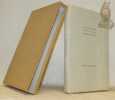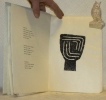-
Type
Art print (1)
Artists book (8)
Autograph (2)
Book (8595)
Magazine (17)
Manuscript (2)
-
Latest
Last 24h (2)
Last 3 days (2)
Last month (111)
Last week (17)
-
Language
English (3)
French (8621)
Latin (1)
-
Century
16th (4)
17th (8)
18th (34)
19th (255)
20th (1342)
21st (169)
-
Countries
Belgium (1196)
Canada (12)
Côte d'Ivoire (11)
France (5228)
Greece (2)
Italy (33)
Switzerland (2143)
-
Syndicate
ALAC (12)
CLAM (1)
CLAQ (11)
CNE (1)
ILAB (872)
NVVA (93)
SLACES (93)
SLAM (555)
SNCAO (62)
HISTOIRE D'UN OUBLI
Paris Grasset 1968 in 8 (19,5x12,5) 1 volume broché, 249 pages [1], non coupé. Edition originale tirée uniquement à 24 exemplaires numérotés sur vélin Alfa, celui-ci un des 10 exemplaires de vente (numérotés de 1 à 10). Bel exemplaire ( Photographies sur demande / We can send pictures of this book on simple request )
Très bon Broché Ed. originale
Les yeux de dix-huit ans.
Paris, Librairie Gallimard, 1928. 12 x 19, 213 pp., broché, bon état.
N° 386 sur 796 exemplaires numérotés sur vélin pur fil Lafuma-Navarre.
L'INQUIETE PATERNITÉ
Paris Editions de la Nouvelle Revue Française NRF 1911 in 8 (22x16,5) 1 volume broché, 172 pages [2]. Collection blanche. Edition originale collective, celui-ci un des 30 exemplaires de tête réimposés in-quarto Tellière sur papier Vergé d'Arches, seul grand papier. Bel exemplaire ( Photographies sur demande / We can send pictures of this book on simple request )
Très bon Broché Ed. originale
"Traités (3 volumes) 1 : L'enfant qui s'accuse; 2 : Césaire ou La puissance de l'esprit; 3 : Dialogues avec le corps endormi."
Paris, Gallimard, 1927. "11 x 16, 3 volumes, 77 + 83 + 69 pages, broché, non coupé, bon état (quelques rares rousseurs; tête roussie)."
"Edition original; N° 534 sur 764 exemplaires numérotés."
Un homme heureux. Collection In-octavo, n.° 9.
Paris, NRF, Nouvelle Revue Française 1929, 230x140mm, frontispice, 205pages, broché. Edition originale sur papier de Hollande Pannekoek filigrané à la gerbe, numérotée n.° 282 / 300, premier tirage avant des exemplaires sur papier chiffon de Bruges tirés en nombre illimité. Très bel exemplaire.
Pour un paiement via PayPal, veuillez nous en faire la demande et nous vous enverrons une facture PayPal
L'AMOUR, LE PRINCE ET LA VERITÉ. Un acte illustré d'eaux-fortes dessinées et gravées par Jeanne Rosoy
Paris Au Sans Pareil 1927 in 8 (19x14,5) 1 volume broché, couverture rempliée, 90 pages [2], illustré de 11 eaux-fortes par Jeanne Rosoy, dont 2 hors-texte (11 engravings by Jeanne Rosoy), dos et plat supérieur de la couverture légérement insolés. Edition originale. Tirage limité à 712 exemplaires numérotés, celui-ci un 600 exemplaires numérotés sur papier vélin Montgolfier. Bel exemplaire ( Photographies sur demande / We can send pictures of this book on simple request )
Très bon Broché Ed. numérotée
LE TEMPS DES BATEAUX À VAPEUR.
Hauterive. Editions Gilles Attinger. 1986. In-12 broché. Frontispice en couleurs contre collée, vignettes et planches hors texte. 78 pages. E.O. Très propre; pages non coupées.
Franco de port France jusqu'à 29 euros iclus. MONDIAL RELAY pour : FRANCE, Portugal, Pologne, Espagne, Allemagne, Autriche, Pays Bas, Luxembourg, Italie, Belgique. Toutes les étapes sont accompagnées. Achat, estimations et listages France / Suisse (sur rdv).
Les plus belles miniatures de la Bibliothèque cantonale de Lucerne. Vol. 1.Coll. “Les plus belles miniatures des bibliothèques suisses”.
Lucerne, Société Suisse des Bibliophiles 1941, 330x250mm, 36pages, feuilles sous couverture cartonnée. Dos toilé. Titre doré au dos. Tirage limité. Exemplaire numéroté, N°95/250.
53 planches en couleurs et n/b, Pour un paiement via PayPal, veuillez nous en faire la demande et nous vous enverrons une facture PayPal
Hermann Hesse und Thomas Mann.
Olten, Vereinigung Oltner Bücherfreunde 1950. 8°. 48 S. Oiginalpergamentband mit goldgeprägtem Rücken- und Deckeltitel, einfacher Deckelfiletierung, Kopfgoldschnitt, in Schuber aus der Werkstatt Emil Kretz, Basel.
"8. Sonderpublikation der Vereinigung Oltner Bücherfreunde". - Nr. XIV der 25 römisch numerierten und signierten Exemplare der Ausgabe "A". - Vortrag gehalte im Juli 1950 auf Einladung des "Kulturbundes" Stuttgart. - Neu.
Charme de vivre. Poèmes.
Genève, Perret-Gentil 1987, 220x155mm, 69pages, broché, couverture à rabats. Dédicacé. Non coupé. Très bel exemplaire. Exemplaire sur papier volumineux sans bois, numéroté n.° 43 / 50.
Pour un paiement via PayPal, veuillez nous en faire la demande et nous vous enverrons une facture PayPal
IN SEARCH OF STEINBECK. Photography by Richard S. Mayer. Illustrations by Wayne Garcia
Los Altos, California Hermes Publications 1978 in 8 (25x17) 1 volume reliure toilé grége de l'éditeur, dos et plat supérieur titré, plat supérieur orné d'une vignette photographique en coulkeurs contrecollée, 181 pages [1], étui toilé assorti. Photos of homes where Steinbeck once lived taken by Richard Mayer. Drawning by Wayne Garcia. First Printing. Edition limited to 1200 numbered copies signed by Anne-Marie Schmitz. Exemplaire numéroté, avec la signature manuscrite de l'auteur sur la justification (signed by author on the last page). Envoi autographe signé par l'auteur (de son prénom seul). Très bel exemplaire ( Photographies sur demande / We can send pictures of this book on simple request )
Très bon Reliure Signé par l'auteur
A travers la durée. Ardoises de Raoul Ubac.
Paris, Editions Fata Morgana 1975, 290x185mm, en feuille non coupée et non paginée, sous chemise à rabats et étui rigide. Un des 60 exemplaires sur papier japon blanc Shiohara, comprenant huit linogravures, et huit gravures sur ardoises tirées à la main directement sur la pierre, numéroté n.° 31 / 60. Signés au colophon par l’auteur et l’artiste. Composée ent Times romain de corps 12, mise en page par Bruno Roy, et imprimée en janvier 1975 par l’Imprimerie de la Charité à Montpellier pour le texte et les linogravures, et par le peintre lui-même pour les gravures sur ardoise. Très bel exemplaire.
controle effectué : 17 gravures n/b, dont le frontispice (seul signé par l’artiste) et dont 3 in texte, Pour un paiement via PayPal, veuillez nous en faire la demande et nous vous enverrons une facture PayPal
Die ewige Krone.
Olten, Vereinigung Oltner Bücherfreunde 1954. 8°. 71 S. Originalhalblederband aus goldbraunem Oasenziegenleder mit Kopfgoldschnitt in Schuber aus der Werkstatt von Max Grollimund, Basel.
"62. Publikation der Vereinigung Oltner Bücherfreunde". - Wilpert-G. 162. - Erste Ausgabe. - Eines von 100 numerierten und signierten Exemplare der Vorzugsausgabe "B".
Messages clandestins et nouveaux poèmes (KASSIBER und neue Gedichte)
Noah In-8, broché, couverture souple unie élégante, 237 pages pour cet ensemble couché sur un vergé de remarquable fraîcheur.
Publié avec le concours du Centre National Des Lettres- Exemplaire découvert en Allemand par Raoul Bécousse qui en fit une remarquable traduction Française et remporta un prix pour la qualité de son travail. Très Bon Etat Franco de port France jusqu'à 29 euros iclus. MONDIAL RELAY pour : FRANCE, Portugal, Pologne, Espagne, Allemagne, Autriche, Pays Bas, Luxembourg, Italie, Belgique. Toutes les étapes sont accompagnées. Achat, estimations et listages France / Suisse (sur rdv).
Die Kunst im deutschen Buchdruck.Aus der Sammlung Ida Schoeller in Düren ausgestellt in der Gruppe Bibliophilie der Weltaustellung für Buchgewerbe und Graphik, Leipzig 1914.Mit einem Geleitwort von Otto Zaretzky.
Weimar, Gesellschaft der Bibliophilen 1915, 325x240mm, XI- 113Seiten, Halbeinband mi Eckbeschlägen. Vergoldene Buchschnitte. Eine Ecke ist beschädigt, sonst schönes Exemplar.
110 Kunstblätter s/w, Pour un paiement via PayPal, veuillez nous en faire la demande et nous vous enverrons une facture PayPal
AINSI VA LA FRANCE
Paris René Julliard 1957 in 8 (20,5x14) 1 volume broché, couverture à rabats illustrée en noir et blanc, 380 pages [2]. Traduit de l'americain par Patricia Davenport. René Julliard, Genève 1900 - Paris 1962, éditeur français, fondateur des Editions Julliard. Envoi autographe signé par l'auteur à son éditeur René Julliard et Gisèle Julliard. Bel exemplaire ( Photographies sur demande / We can send pictures of this book on simple request )
Très bon Broché Signé par l'auteur Ed. originale
Bijdrage tot de geschiedenis van de renaissance der Nederlandse boekdrukkunst.
, Amst., Buhrmann, 1952., Oorspr. omslag. Onafgesneden, in-4? . Met 16 afbeeldingen in facsimile, 56 pp.
Redevoering gehouden op 19 mei 1949 tijdens de Algemene Ledenvergadering van het Provinciaal Utrechts Genootschap van Kunsten en Wetenschappen.Utrecht, School voor de Grafische vakken, 1952. Oorspr. omslag. Onafgesneden. Met 16 afbeeldingenGedrukt door Joh. Enschede in rood en zwart op diverse papiersoorten. - Typogr. verz. s.h. de Roos.
Audax omni perpeti. Gedichte.
Leipzig, Insel Verlag (1922). Gross-8°. 41 S., 2 n.n. Bl. Violetter Originalmaroquinband mit goldgeprägtem Rücken- und Deckeltitel, Deckelbordüren mit Eckfleurons und Kopfgoldschnitt (Heinrich & Scheffel, Leipzig).
«Zweites Buch der Insel-Presse.» - Sarkwoski 1533. - Zweite Ausgabe dieser, hautpsächlich in Holland und Geerten Gossaert gewidmeten Gedichte. - Nr. 23/150 numerierten Exemplaren auf Bütten (+ 25 nicht für den Handel bestimmten Ex.). Nur ein kleiner Teil von ca. 30 Exemplaren wurde in Ganzleder gebunden. Unser Exemplar identisch mit dem Einand eines Exemplares aus der Auktion Christian Hesse 6/369, der den unsignierten Einband nach Vergleich der Binderei Heinrich & Scheffel zuschreibt. - Ecken und Rückenbünde mit berieben. Schwache Schabspuren auf dem Vorderdeckel.
À CONTRE-COURANT. «Journal dun écrivain non engagé». [
Genève]. Editions Perret-Gentil. 1970. Grand in-8° broché. 234 pages. E.O. sur papier ordinaire. Envoi autographe signé et belle lettre manuscrite de lauteur à lun de ses anciens professeurs. Bon état.
Franco de port France jusqu'à 29 euros iclus. MONDIAL RELAY pour : FRANCE, Portugal, Pologne, Espagne, Allemagne, Autriche, Pays Bas, Luxembourg, Italie, Belgique. Toutes les étapes sont accompagnées. Achat, estimations et listages France / Suisse (sur rdv).
Ankedoten aus dem Leben grosser Deutscher. Mi zwei Holzschnitten und einer Vignette von Arno Waldschmidt.
Ottiglio, Verlag Klaus G. Renner, 2003. 35,7x25,8 cm. 12 n.n. Bl. Originalpappband.
Erschien in einer Auflage von 110 arabisch numerierten und 15 römisch numerierten Exemplaren, unser Exemplar ist nicht numeriert, von Schulte und Waldschmidt signiert. - Gedruckt bei der Offizin Haag-Drugulin in Leipzig, Einband von Host Zemann.- Sehr schönes Exemplar.
LE RENDEZ-VOUS AVEC QUELQU'UN
Paris René Julliard 1962 in 8 (21x13) 1 volume broché, 174 pages [1]. Collection du prix international du premier roman. Maurice Schumann, Paris 1911-1998, homme d'Etat, journaliste et écrivain français. Edition originale, celui-ci un des quelques exemplaires d'auteur (justifiés HC), avec 30 exemplaires numérotés de 1à 30 sur alfa des papeteries d'Avignon (seul grand papier). René Julliard, Genève 1900 - Paris 1962, éditeur français, fondateur des Editions Julliard. Envoi autographe signé par l'auteur à Gisèle et René [Julliard, son éditeur). Bel exemplaire ( Photographies sur demande / We can send pictures of this book on simple request )
Très bon Signé par l'auteur Ed. originale
LE VRAI MALAISE DES INTELLECTUELS DE GAUCHE
Paris Plon 1959 in 8 (20,5x14) 1 volume broché, 53 pages [1]. Collection '' Tribune libre '', 11. Exemplaire de service de presse. Maurice Schumann, Paris 1911-1998, homme d'Etat, journaliste et écrivain français. René Julliard, Genève 1900 - Paris 1962, éditeur français, fondateur des Editions Julliard. Envoi autographe signé par l'auteur à l'éditeur René et Gisèle [Julliard]. Bel exemplaire ( Photographies sur demande / We can send pictures of this book on simple request )
Très bon Signé par l'auteur Ed. originale
NANCY
Paris Editions Emile-Paul Frères 1926 in 8 (20x15) 1 volume broché, couverture illustrée rempliée, 101 pages [1], avec une lithographie de Dufrenoy en frontispice. Collection '' Portrait de la France '', 7. Tirage à 1650 exemplaires numérotés, celui-ci un des 1500 exemplaires numérotés sur vélin Lafuma. Edition originale. Bel exemplaire ( Photographies sur demande / We can send pictures of this book on simple request )
Très bon
Librarium. Revue de la Société Suisse des Bibliophiles. Zeitschrift der Schweizerischen Bibliophilen Gesellschaft. 1958, Heft 1-3
Zürich Schweizerische Bibliophilen-Gesellschaft 1958 3 volumes in-8 brochés de 68; 64 et 64 pages, couvertures imprimées en deux tons.
Illustrations en noir in texte. Première année. Complet des 3 volumes publiés pour l'année 1958. Texte en allemand.
Librarium. Revue de la Société Suisse des Bibliophiles. Zeitschrift der Schweizerischen Bibliophilen Gesellschaft. 1959, Heft 1-3
Zürich Schweizerische Bibliophilen-Gesellschaft 1959 3 volumes in-8 brochés de 201 pages (pagination continue), couvertures imprimées en deux tons. Tache sur le premier plat du troisième cahier.
Illustrations en noir et en couleurs in texte. Deuxième année. Complet des 3 volumes publiés pour l'année 1959. Texte en allemand.
 Write to the booksellers
Write to the booksellers











